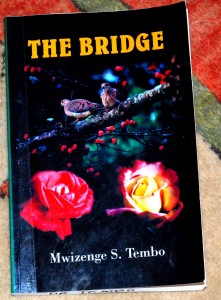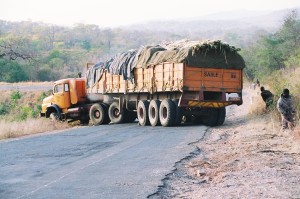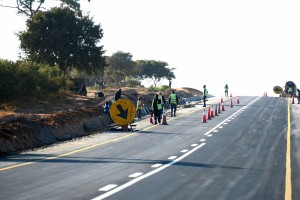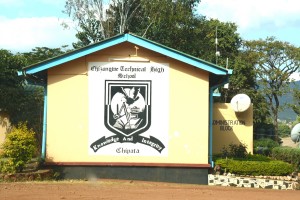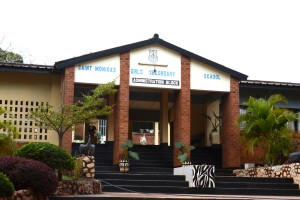by
Mwizenge S. Tembo, Ph. D.
Professor of Sociology
Introduction
Since the Curriculum Development Center (CDC) of the Ministry of Education approved my novel “The Bridge” to be used for teaching English Literature in Secondary Schools from Grade 10 to 12, there was one thing I was very anxious to do: I wanted to go to a few Secondary Schools. I wanted teachers and students to meet the author of the novel directly. Most of the knowledge we acquire in Zambia is foreign. Not that there is anything wrong with foreign knowledge, products, ideas,
books, or novels, but there is a need for Zambians to realize that we as Zambians can do many of the things that are always from foreign countries. That will gradually build our confidence.
When I arrived in Lusaka, I made the radio and television appearances. I wanted to visit some secondary schools in the Eastern and North-Western Provinces of Zambia. How was I going to do this?
Using a Vehicle
I could have used the bus like I often do. Since I had so many commitments and did not have the whole year for the 2 trips, I decided the best way to visit the few schools was using a rental vehicle. Fortunately Avis at Kenneth Kaunda International Airport in Lusaka had just the vehicle I needed: the F 15 Double Cab diesel Ford Ranger. As soon as I left the Airport Parking lot, I noticed a distinctive personality of the diesel vehicle. It had tremendous power to tackle the steep mountains of the Muchinga escarpment but also it did not hum or whine, instead it growled which was reassuring.
Lusaka to Lundazi
I was excited, full of energy, and pumped up for the journey to Lundazi. I filled up the tank. The last was to stop at the farm in Ibex Hill in Chainda where my aunt had prepared nshima with two tender nicely roasted doves as relish. I was ready. The journey to Chipata is slow until after Chongwe when you begin to hit major road marks; the tsetse control barrier-check point is one of
them. The most challenging part of the trip is between Rufunsa and Nyimba. This is where you encounter the Mchinga escarpment hills, sharp bends, and steep climbs. Trucks loaded with hundreds of bags of maize, cotton, and other commercial products may end up using all their more than 12 gears. The F15 Ford Ranger simply growled through the steep hills and ninathila dizilo as I poured diesel according to the Zambia parlance. As you navigate through the sharp bends, your foot has to quickly, constantly, and carefully move from the accelerator, brakes, and the clutch to down or up the gears. You have to focus because often a huge surprise could be just around the sharp bend.
Manenekera
Just after Rufunsa there is 10 km or 6 miles stretch of the road which includes the treacherous and dangerous manekera. It is no longer dangerous as the new Zambia government at
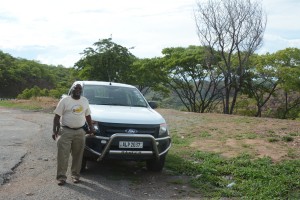
Manenekera are just behind me on the right. In the 1950s I would not have been able to park where I did.
Independence in 1964 fixed the road which the British colonizers had been unable or unwilling to do. But in the 1950s the rough gravel road was perched on the edge of the mountain where only one vehicle could travel at any one time. Any mishap including brake failure result into the vehicle, truck, or bus plunging may be a thousand feet down the abyss of a steep embankment.
I stopped briefly at Luangwa bridge at 4:00pm and bought some dry fish to eat in the village. I crossed the massive Luangwa suspension bridge and arrived at Nyimba at about 6:00pm as it was getting dark. The road was being repaved from Luangwa all the way to Chipata. There were some detours. The new repaved road was good and spectacular with a wide shoulder for bicyclists, pedestrians, and ox-drawn carts. When it got dark the marked road with reflectors looked like a well-lit airport runway all the way to Chipata where I arrived at about 8:00pm and spent the night.
Village F 15 Surprise.
The 746 Kms from Lusaka to Lundazi are all paved except the last 33 Kms or 21 miles to my home village. I drove through a gravel road that had not been graded for nearly 2 years. The final 2 Kms to my village had a surprise. I was crossing a dry creek which had a wooden bridge which another nearby village driver used to cross with his SUV. The F 15 growled at the bottom of the small creek and rose out of the embankment, immediately there was a noisy piercing screech only on the driver’s side of the front wheel when I hit the brakes. The screech lasted all the way to the village. I was worried
The following morning at 7:00 am I wanted to drive to the next village to visit, when to my horror the entire clutch pedal for some unknown reason was on the floor. It was impossible to change gears. I panicked. I had to be back in Lusaka in a few days. Besides visiting with parents and all the relatives in the village, I did not have time to attend to a major vehicle mechanical failure. I called Avis in Lusaka. The manager calmly told me they could send another vehicle that could be there before the end of the day. That was reassuring. But I told them to hold on.
Before the end of the day with the use of the widely available cell phones, someone brought two small bottles of clutch fluid by minibus from town. The local mechanic came and fixed the minor problem. Avis did not have to send another vehicle all the way to the village 746 kms from Lusaka.
Village Life
Village and small town life in the Eastern part of Zambia in 2016 is good. People are building
more brick houses in the villages and purchasing a few iron roofing sheets at a time after they have sold their cotton and other agricultural produce. People are suing solar power for charging phones and for house lights. Up and down the entire road from Lusaka to Lundazi people just look visibly busy, healthy and happy. This does not mean if I asked the people they would say they have no problems; unemployment, illness, prices of farm produce, poverty, problems which school fees for children’s educations, and problems with fertilizer for farming. The massive road paving and construction camps along the Lusaka Chipata road suggests people have jobs although this might be temporary. Signs of commerce are everywhere. My father is 93 years old and my father is about 90 years old. They are alive, healthy, and happy in the village. They have seen so much change in Zambia since the mid 1940s when they married. My father then started his primary school teaching career.
Return to Lusaka
I delivered a copy of my novel: “The Bridge” to Lundazi Secondary School, Chizongwe Secondary School, and St. Monica’s Secondary School. My return to Lusaka was smooth and uneventful. I stopped at Nyimba at 10:00am and ate my breakfast of nshima with rape and chicken. I arrived in Lusaka at 14:00 hours or 2:00pm. By they way, the screeching on the driver’s side front wheel stopped after driving on the paved road from Lundazi to Chipata for about half an hour. It seems the screech may have been related to driving on a very dusty road to the village.
